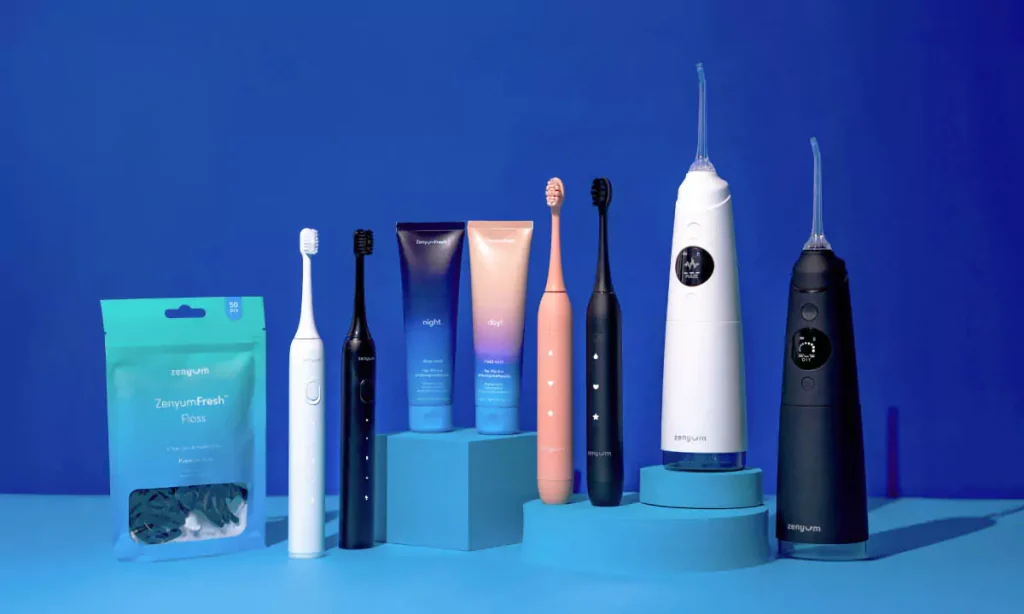Ever wondered how to tackle gum disease without a trip to the dentist? Questioning if home remedies really work?
Gum disease, also known as periodontal disease, starts with plaque buildup and can cause bleeding, redness, and swelling. Early intervention is key to preventing tooth loss which is why we’re here to provide the insights on the stages, causes and possible ways to prevent and treat it.
This article is for informational purposes only and is not intended to be taken as medical advice. Please consult with your treating dentist for medical advice specific to your condition. Zenyum does not provide medical advice and our systems are doctor-directed treatments.
Stages and Symptoms of Gum Disease

How do I know if it’s serious? Being aware of subtle indications to clearer signs can aid you in addressing gum disease before it escalates. In this section, we’ll delve into the stages of gum disease, shedding light on their unique symptoms and what makes each stage different.
Stages | Symptoms | Severity and Treatment |
Gingivitis | The earliest stage of gum disease typically starts with
particularly during brushing or flossing. | At this stage, the infection is confined to the gum tissue and is reversible with proper oral care. |
Early Periodontitis | The infection has now spread beneath the gum line, causing damage to the tissue and bone supporting the teeth. Symptoms may include
| May be reversible with proper care, particularly if detected and addressed early. May be reversible with proper care, particularly if detected and addressed early. Without intervention, the condition may continue to worsen. |
Moderate Periodontitis | This stage indicates increased destruction of the supporting tissues and bone. This can lead to
| |
Advanced Periodontitis | The most severe stage of gum disease whereby
| This stage often requires professional intervention to manage effectively. |
Causes of Gum Disease
So, what’s the deal with gum disease? Well, it turns out, it’s not just about forgetting to brush or skipping that flossing session. There’s a whole host of everyday habits and factors that can push us closer to gum disease territory.
Slacking on Oral Hygiene
Yes, we’re talking about not giving those pearly whites the TLC they deserve. When we don’t brush and floss enough, plaque and tartar start to throw a party on our teeth, irritating the gums and setting the stage for gum disease.
Tobacco use
Whether you’re smoking cigarettes or chewing tobacco, these habits weaken our body’s defenses and mess with blood flow to the gums, paving the way for gum disease to waltz right in.
Genetic factors
Believe it or not, some individuals may be genetically predisposed to gum disease, making them more susceptible to its development.
Certain medical conditions
Conditions such as diabetes, hormonal changes (such as during pregnancy or menopause), and autoimmune diseases can ramp up the risk of gum disease. It’s like our body’s way of saying, “Hey, don’t forget about those gums!”
Poor nutrition
Ever heard the saying, “You are what you eat”? Well, our gums feel that too. Skimping on essential nutrients, especially vitamin C, weakens our immune system and makes it harder for the body to fight off gum infections.
And there you have it—gum disease isn’t just about forgetting to floss once in a while. It’s a whole symphony of habits and factors that can either keep our gums happy or invite trouble.
Possible Ways to Prevent Gum Disease at Home
While it’s crucial to seek professional care from dentists to effectively manage gum disease, integrating natural remedies into your overall approach can also help, especially in prevention.
Let’s explore practical ways to prevent and treat gum disease from the comforts of your own home, complementing professional dental treatment for optimal oral health.
1. Proper oral care habits

Good oral care habits are your first line of defense against gum disease. Some habits include:
- Brush your teeth twice a day, dedicating two minutes to each session for a thorough clean
- Focus on the right brushing technique to reach under the gum line
- Make sure your toothbrush is always in good shape by replacing it every three months
- Choose a dentist-recommended toothpaste to keep your teeth and gums healthy
- Floss at least once a day
- Rinse mouthwash twice a day as part of your brushing routine
2. Regular dentist visits
Another good practice would be to schedule dental appointments every 4-6 months (or as recommended by your dentist) to do scaling and polishing. This involves removing stubborn plaque and tartar buildup around the teeth and along the gum line, thus improving your oral health.
3. Green tea
Sipping on green tea might do more than just relax you. Thanks to its antioxidant properties, green tea can possibly help reduce inflammation and combat bacteria in your mouth.
The magic ingredient here is catechins, a type of polyphenol that may inhibit the growth of bacteria that lead to gum disease. Adding a cup or two of green tea to your daily routine could be a simple way to boost your gum health.
4. Salt water
A salt water rinse may be a simple solution but it could potentially help reduce inflammation and calm irritated gums. Salt water can create a less hospitable environment for harmful bacteria, contributing to better oral hygiene, in addition to helping remove leftover food particles from your mouth.
5. Healthy diet
Did you know that there’s a link between your diet and gum health? Incorporating a diet packed with nutrient-rich foods can boost your immune system, helping your body fend off infections that affect your gums. Aim to include more fruits, vegetables, lean proteins, and whole grains in your meals, while cutting down on sugary foods and beverages.
Though these approaches can be very helpful, it is important to remember that they are not a substitute for regular dental visits and maintaining proper oral hygiene. Always consult your dentist for advice suited to your specific condition.
FAQs about Gum Disease Treatment
Can I prevent gum disease?
Yes, you can! Keeping up with your oral hygiene such as brushing twice daily, daily flossing, maintaining a healthy diet low in sugary foods and beverages, regular dental check-ups, and avoiding tobacco can help keep it in check.
Is gum disease contagious?
Gum disease can be contagious as the bacteria responsible for gum disease is able to be transmitted from person to person.
Although you can’t develop gum disease through brief or casual contact, prolonged and repeated exposure to saliva, such as through intimate contact like kissing, may increase the risk of developing gum disease.
Is gum disease treatable?
Gum disease is treatable! However, treatments may vary depending on the severity of the infection. Most cases of gingivitis can be managed with improved oral hygiene practices at home and regular dental cleanings.
As it progresses to periodontitis, more advanced interventions by a dentist and a blend of better oral care at home may be necessary.
How do dentists diagnose gum disease?
Dentists diagnose gum disease by visually examining your gums for signs like redness, swelling, or bleeding. They may also measure the depth of pockets between your teeth and gums and use X-rays to check for bone loss. Your dentist will also consider your medical history and any symptoms you report. Early diagnosis is key to stopping gum disease in its tracks.
How is gum disease treated by dentists?
Treatment for gum disease varies depending on its severity and other factors. Common treatments may include:
- Getting your teeth professionally cleaned
- Deep cleaning
- Taking antibiotics or using special mouth rinses
- Surgery, such as a gum graft or flap surgery
Your dentist will chat with you about the options that are best for your smile. Early intervention is crucial for successful treatment and preventing further damage.
When should I see my dentist about gum disease?
If you’re seeing signs like bleeding gums or noticing your breath isn’t as fresh as it used to be, it’s a good idea to schedule a visit with your dentist. And hey, if gum issues run in the family or you’re a smoker, regular check-ups are extra important. Don’t wait until it’s too late – catching gum disease early can make all the difference.
Don’t let gum disease sneak up on you
Defend your best smile with our full range of Smile Cosmetics!





